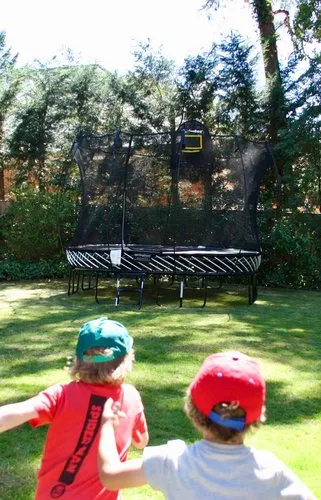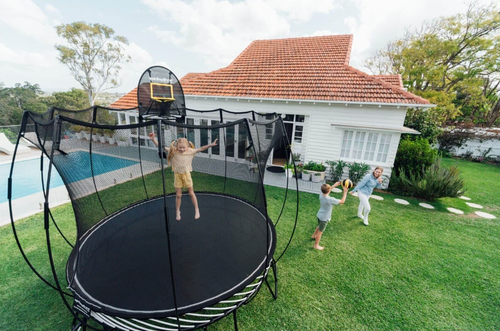Did you know that the average person spends almost seven hours a day on a screen?
Did you also know that people defined as Generation Z (1997-2013) spend on average around 9 hours on a screen every day?
Whether it be your phone, TV, laptop or tablet, screens consume much of our daily life. If you’re a parent, the statistics above, courtesy of Exploding Topics, could be alarming to you.
Too much screen time can be detrimental to the development of your children, and as a parent that wants the best for your little ones, it’s helpful to have some advice on how to balance screen time for your kids in a healthy way.
At Springfree Trampoline, we believe in inspiring joyful moments for families and one of the best ways to do that is by enjoying activities beyond those that involve a screen.
Screens are a part of our life and they’re not going away anytime soon, but having a healthy balance between screen time and non-screen time can make a major difference for both the physical and mental growth of your child.
In this article, we will be providing five expert-led tips to limit screen time for your kids. Since we are in the trampoline industry, we will also go over some of the benefits of trampoline jumping as an outdoor activity for kids.
Before we get to all of that though, let’s discuss why it’s crucial to limit screen time, particularly for children...
Why Is It Important to Limit Screen Time for Kids?
Too much screen time can result in a multitude of issues for your children. According to the Mayo Clinic Health System, these include:
- Obesity
- Irregular sleep
- Behavioural problems
- Impaired academic performance
- Violence
- Less time for play
Screen time-related issues are even more acute for Primary school children or younger. According to data from the Canadian Healthy Infant Longitudinal Development (CHILD) study, primary-level school children who spend over two hours a day on screens are more likely to suffer from social, emotional and attentional issues.
Research clearly shows a correlation between screen time and negative effects. So, how do you limit screen time and balance it with more advantageous activities?

5 Tips to Limit Screen Time for Kids
Let’s now look at five tips for balancing your child’s screen time healthily and productively:
Make a List of Pre-Screen Time Activities
One of the best ways to limit screen time for your kids is to make screen time a reward. A good way of doing this is through mandatory activities that need to be completed before screen time is allowed.
An example schedule could include:
- Read a book (30 minutes)
- Do an activity outside (30 minutes)
- Study and finish homework (30 minutes)
- Do something creative, like drawing, painting, playing music or dancing (30 minutes)
That’s two hours of non-screen time, and after these activities are completed, screen time can then be allowed for however much time they have before bed.

Create a Chore or Task Board
Another way to accomplish rewarding screen time to your kids based on mandatory activities is creating a chore or task board.
The benefits of this are two-fold: One, you’re limiting their screen time and two, you’re teaching them the importance of working to attain a goal. You’re also taking some of the daily chores off your back, which never hurts!
Bonus Tip: Have your kid do outside chores, like picking up toys or watering the garden. This gets them outside and active.
Schedule Predetermined Screen Time
This next tip ties into the scheduling theme of this article so far, but a helpful way to limit screen time is to allocate specific times when screen time is allowed.
For instance, you may want to allocate two hours of screen time for younger children in primary school. If you designate 6-8 P.M. as screen time for your child during the week and stick to that schedule, it will set a consistent standard for screen time.
Bonus Tip: There are also some devices where you can set time limits on certain apps or even the device itself. Check out Apple’s iPhone User Guide for steps on how to set limits on screen time and apps on your iPhone.
Set a Time at Night to Turn in Electronics
Let’s be honest, we’ve all been guilty at some point in our life of breaking a rule set in place by our parents.
If your rule was two hours of screen time, but your child decides to break this rule by sneaking a tablet into their room after hours, then the rule has lost its meaning, right?
To help avoid screen time rule-breaking, have your child turn in all electronics before going to bed and place them in a hidden spot in your room. This ensures that screen time is truly limited, and your rule is being followed.
Set Summer Screen Time and Weekend Boundaries
“So, I have a plan for limiting screen time during the week but what about the summer and weekends, when kids have more free time?”
Screen time will be naturally increased during the summer and weekends, but that doesn’t mean you can’t set boundaries on how much time your child spends around a screen.
You can still do the pre-screen mandatory activities and chores, but instead of two hours of screen time, maybe you increase it to three or four and put more of an emphasis on other activities.
There’s also the idea to make screen time educational time. If you find that there is a lot of downtime in the summer or on the weekend, maybe allocate some time each day for your child to play a video game or watch a video that is instructive and informative.
If you’ve read this far, you could probably guess that a key part of limiting screen time is getting outside. But what activities would get your child excited to go outside and be active rather than inside and glued to a screen?
Since we sell trampolines, which is a common childhood outdoor activity, we’re going to stick to what we know and go over some of the benefits of trampoline jumping for kids:
Benefits of Trampoline Jumping for Kids
Here are some of the major benefits of trampolines for kids:
- Trampolines are a fun way to get exercise outdoors for kids.
- Trampolines come with numerous health benefits, such as improving your cardio and balance.
- Trampolines allow kids to be creative.
- Trampolines are low impact, which protects joints and growing bodies.
- Trampolines can be used for multiple activities, like trampoline games or trampoline sleepovers.
- Trampolines can be enjoyed with others (although Springfree recommends the “One Child at a Time” Rule”).
If you’re looking to compliment screen time with an outdoor activity, buying a trampoline could be an option for you.
Read through our article on what to look for when buying a trampoline to learn more about whether investing in a trampoline would be right for you.

Is a Springfree Trampoline Right for You?
Limiting screen time is a goal many parents strive to incorporate into their kids’ daily lives.
Using the five tips above should give you some practical actions to achieve the goal of reducing screen time for your kids.
As you now know, one of the best ways to limit screen time is by getting your child active outdoors.
Because of the safety and springless design of our products, our trampolines cost somewhere in the £1,095-£1,695 range, meaning it will not be an inexpensive purchase and should be researched ahead of time to make sure it would be a good investment for your family.
If you’re interested in looking into a Springfree Trampoline, check out our article, "Are Springfree Trampolines Worth the Money?" to see if a trampoline might be a solution to limiting screen time for your kids!










